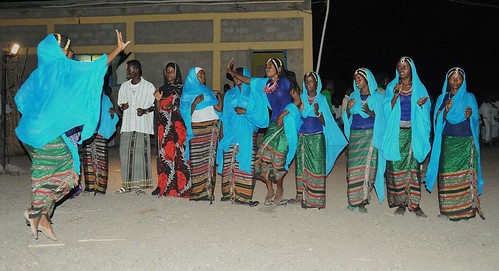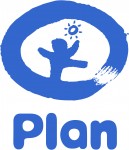Title: Awash to Mille
Dates: 22nd to 25th July GPS:
Distance: 320km Total Distance: 20,164km
Roads: Excellent tarmac, gently undulating
Weather: Warm (mid 30s), thunderstorms
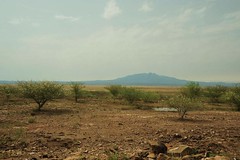 Once we had turned away from Awash, a sensitive military region and headed towards the desert, I felt a sense of relief. I pedalled north through scrubby acacia bushland and vast open plains; some spectacular mountains in the distance on either side of the road. A tail wind enabled me to zip along the tarmac. The road is the main trucking route for Ethiopia which ends at the port in Djibouti. The highway was very busy however I found the truck drivers, on the whole, very friendly and respectful – they gave me plenty of space.
Once we had turned away from Awash, a sensitive military region and headed towards the desert, I felt a sense of relief. I pedalled north through scrubby acacia bushland and vast open plains; some spectacular mountains in the distance on either side of the road. A tail wind enabled me to zip along the tarmac. The road is the main trucking route for Ethiopia which ends at the port in Djibouti. The highway was very busy however I found the truck drivers, on the whole, very friendly and respectful – they gave me plenty of space. 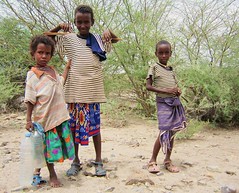 As I headed towards Mille, 320km from Awash, the vegetation gradually petered out and the plains resembled the Nullarbor, although a little more undulating. The people were different too. Afar nomads, often children, tended to their herds of sheep, goats, camels and/or cattle. Adults, even some women carried guns as a normal part of life, which they needed to protect their livestock from Somali animal rustlers and hyenas mostly. The number of guns around was a bit unnerving initially. In general, the children were inquisitive and friendly and I wasn’t hassled by aggressive begging kids.
As I headed towards Mille, 320km from Awash, the vegetation gradually petered out and the plains resembled the Nullarbor, although a little more undulating. The people were different too. Afar nomads, often children, tended to their herds of sheep, goats, camels and/or cattle. Adults, even some women carried guns as a normal part of life, which they needed to protect their livestock from Somali animal rustlers and hyenas mostly. The number of guns around was a bit unnerving initially. In general, the children were inquisitive and friendly and I wasn’t hassled by aggressive begging kids.
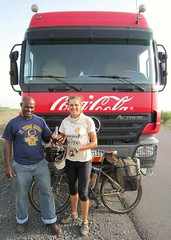 A few kilometres after Gewane, half way to Mille, I clocked my 20,000th kilometre. The scene was rather different from the 10,000th kilometre and the shooting incident in the Republic of Congo. We camped after 190km at a communications tower which was protected by armed police. Nearer to Mille, the land became stony and desolate. Normally at this time of year temperatures soar into the mid-40s most days, but the rains over the last few days had kept the climate cooler.
A few kilometres after Gewane, half way to Mille, I clocked my 20,000th kilometre. The scene was rather different from the 10,000th kilometre and the shooting incident in the Republic of Congo. We camped after 190km at a communications tower which was protected by armed police. Nearer to Mille, the land became stony and desolate. Normally at this time of year temperatures soar into the mid-40s most days, but the rains over the last few days had kept the climate cooler.
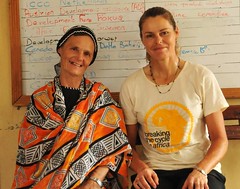 Communications in this region are unreliable and so while I had been emailing Valerie Browning, the person we had come to see, I wasn’t sure whether she would be in Mille, where she is building a hospital or Logia where she and her family lives. We were just about to give up on Mille and head for Logia when she appeared, looking for us. Diminutive in physical size but with a huge presence, she martialled all who were with her, shooed away those who were standing and staring at us (we are used to attracting a crowd at this stage), and brought us to a cafe for a drink and to discuss plans.
Communications in this region are unreliable and so while I had been emailing Valerie Browning, the person we had come to see, I wasn’t sure whether she would be in Mille, where she is building a hospital or Logia where she and her family lives. We were just about to give up on Mille and head for Logia when she appeared, looking for us. Diminutive in physical size but with a huge presence, she martialled all who were with her, shooed away those who were standing and staring at us (we are used to attracting a crowd at this stage), and brought us to a cafe for a drink and to discuss plans.
I particularly wanted to see the hospital she and the Afar Pastoralists’ Development Association (APDA) are building, learn about the mobile health units and mobile classrooms they have pioneered, and other community work of the APDA which benefits the Afar. We sat together on the way to Logia, getting to know each other and discussing development, poverty, various projects and NGOs. I was mostly learning.
 Valerie, an Australian nurse, has been living in the Horn of Africa for more than thirty years. She has nursed famine victims in Ethiopia, helped independence fighters in Eritrea, supported guerrilla soldiers in Djibouti and reported undercover on human rights abuses in Ethiopia; risking her life many times for her belief in justice. Valerie has been married to Ismael, a clan leader of the Afar for 21 years. They have two children, Aisha who is studying in Australia and Rammid (8) who was determined that he wanted to cycle with me through to Somalia!
Valerie, an Australian nurse, has been living in the Horn of Africa for more than thirty years. She has nursed famine victims in Ethiopia, helped independence fighters in Eritrea, supported guerrilla soldiers in Djibouti and reported undercover on human rights abuses in Ethiopia; risking her life many times for her belief in justice. Valerie has been married to Ismael, a clan leader of the Afar for 21 years. They have two children, Aisha who is studying in Australia and Rammid (8) who was determined that he wanted to cycle with me through to Somalia!
Together they have created the APDA which brings education to a culture which had 2% literacy before they began their work and life-saving medical aid and community empowerment to the nomads. The APDA started with 34 committed staff and has now expanded to 750 workers. The Afar people regard Valerie so highly they call her ‘Maalika’ which means ‘Queen’.
We drove directly to the Logia office to meet Ismael and clean up. It had been two long days on the road and even a cold shower was particularly welcome. It was a pleasure to meet Ismael too – a gentle character who also works tirelessly for his people. While the other two were freshening up, Valerie explained that she believed poverty is not simply about living with less than one or two dollars a day, it’s all about lack of empowerment. Not having enough money is a part of it, but often it is a consequence of not having a voice. Education she believes is the key to alleviating poverty (and I agree whole heartedly). Educated people are better able to make decisions and choices. They can learn about the importance of cleanliness and sanitation, understand about the risks associated with FGM (female genital mutilation), they can understand laws, vote and learn life skills for example. Educated people have better health on average, fewer healthier children and have capacity to earn more money. Educated people are empowered to take control and make better decisions for their livelihoods.
The only worthwhile, sustainable type of development is community-based, where local leaders make decisions about their direction and cultural development. Empowering communities with an emphasis on skills transfer is the best possible leg up organisations can give.
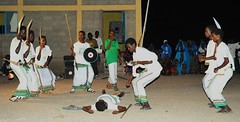 That evening we attended a youth dance performance which was to celebrate the end of a week-long Afar youth conference. Youth from all over the huge Afar region had congregated to exchange ideas and discuss their direction, interact and make friends. The performances were a mix of traditional dances which tell stories and new compositions which generally educate about good health practices and the importance of education. It was an uplifting evening supported by at least a couple of hundred locals in the audience.
That evening we attended a youth dance performance which was to celebrate the end of a week-long Afar youth conference. Youth from all over the huge Afar region had congregated to exchange ideas and discuss their direction, interact and make friends. The performances were a mix of traditional dances which tell stories and new compositions which generally educate about good health practices and the importance of education. It was an uplifting evening supported by at least a couple of hundred locals in the audience.
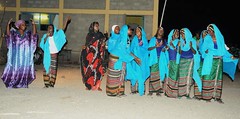 A particular highlight for me was to see the girls perform. This would not have happened a few years ago. Afar women, before the ADPA had 0% literacy. Now these girls have the confidence to sing and dance in front of a crowd. Once the girls had finished, the youth congregated and I was introduced and invited to say a few words (Ismael translating). I kept on with the education theme with the message of the importance of going to school and learning new skills.
A particular highlight for me was to see the girls perform. This would not have happened a few years ago. Afar women, before the ADPA had 0% literacy. Now these girls have the confidence to sing and dance in front of a crowd. Once the girls had finished, the youth congregated and I was introduced and invited to say a few words (Ismael translating). I kept on with the education theme with the message of the importance of going to school and learning new skills.
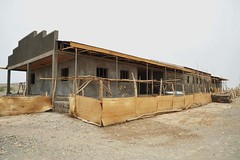 The next day we returned to Mille to look at the hospital. It is getting there, just needs internal furnishings before it can start to be equipped. The main section will contain 28 beds. One end will house all the operating and technical equipment. The other end will have space for teaching to train Afar nurses, birth assistants and medical professionals. Funding is still being sought to complete the centre by 2011.
The next day we returned to Mille to look at the hospital. It is getting there, just needs internal furnishings before it can start to be equipped. The main section will contain 28 beds. One end will house all the operating and technical equipment. The other end will have space for teaching to train Afar nurses, birth assistants and medical professionals. Funding is still being sought to complete the centre by 2011.
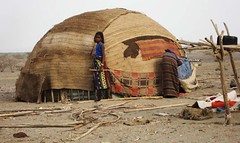 The basis of the APDA health plan is the mobile health units. It is the most practical way of administering healthcare, such as vaccinations to the nomads. The reach communities where there are no roads, Valerie and the team must carry a generator by camel to make ice to keep the vaccines cold. Once they reach an accessible distance, they carry the vaccines packed in ice and walk with the heavy packs for anything up to 14 hours. Over a week she and her team may walk about 300km. The purpose of the centrally located hospital in Mille is to service those who cannot be treated by the mobile health units.
The basis of the APDA health plan is the mobile health units. It is the most practical way of administering healthcare, such as vaccinations to the nomads. The reach communities where there are no roads, Valerie and the team must carry a generator by camel to make ice to keep the vaccines cold. Once they reach an accessible distance, they carry the vaccines packed in ice and walk with the heavy packs for anything up to 14 hours. Over a week she and her team may walk about 300km. The purpose of the centrally located hospital in Mille is to service those who cannot be treated by the mobile health units.
Valerie made particular mention of the major problems the Afar have with women’s reproductive health. 1.7% of Afar women die in child birth and 35% of children don’t live past the age of five years. Millennium Development Goal 5 is the most difficult to deal with due to the traditional practice of FGM. All Afar women traditionally undergo the most severe form of FGM which involves removing both labia and clitoris and then stitching them together. This causes dreadful complications in child bearing and with the kidneys. Valerie explained that one girl at the age of 23 needs a kidney transplant to save her life, due to infections caused by FGM. Valerie had offered one of her own kidneys.
I had also wanted to visit one of their mobile schools to see a class in action. So far the APDA has delivered education to 85,000 children. Students are educated up to year 4 level, learning in their own language. It seems an impressive amount but Valerie is not content with this when there are so many more to educate. There are approximately 1.4 million Afar people. Given that there are 74 million Ethiopians, the Afar are very much a minority group whose rights and needs are generally overlooked by the government.
 Overnight storms had caused local flooding; the Awash and Mille rivers and swelled and caused severe flooding so school was off. Three people had died and many were fleeing to higher ground. Our plan changed. Rather than visit the mobile school, we had to drive the long way round from Mille, back down the Awash Road and along the flood plain to Galha village to where many were seeking refuge. Valerie was on the job immediately, talking with the community leaders and women to find out the extent of the emergency and what the people needed.
Overnight storms had caused local flooding; the Awash and Mille rivers and swelled and caused severe flooding so school was off. Three people had died and many were fleeing to higher ground. Our plan changed. Rather than visit the mobile school, we had to drive the long way round from Mille, back down the Awash Road and along the flood plain to Galha village to where many were seeking refuge. Valerie was on the job immediately, talking with the community leaders and women to find out the extent of the emergency and what the people needed.
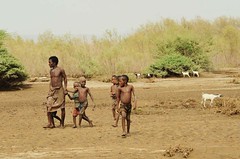 The waters rose quickly and many of the men had to swim their families to safety. About 165 families were displaced at that stage. The people seemed in reasonable condition, but without food and supplies, their health would deteriorate after a few days. Valerie was going to report it to the correct authorities first and wait for their response before going any further.
The waters rose quickly and many of the men had to swim their families to safety. About 165 families were displaced at that stage. The people seemed in reasonable condition, but without food and supplies, their health would deteriorate after a few days. Valerie was going to report it to the correct authorities first and wait for their response before going any further.
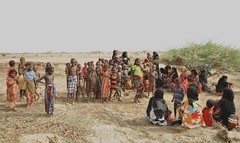 Floods are becoming more of a regular occurrence for a couple of reasons. Over the last seven years, the region has experienced more extremes of climate. Secondly, the flow of the Awash River has been altered since the government built a dam just west of Logia. The reservoir extends for over 30km upstream making the waters behind it susceptible to flooding. The purpose of the dam is to supply 60,000 hectares of prime riverside land with water to irrigate a sugar cane plantation for ethanol production.
Floods are becoming more of a regular occurrence for a couple of reasons. Over the last seven years, the region has experienced more extremes of climate. Secondly, the flow of the Awash River has been altered since the government built a dam just west of Logia. The reservoir extends for over 30km upstream making the waters behind it susceptible to flooding. The purpose of the dam is to supply 60,000 hectares of prime riverside land with water to irrigate a sugar cane plantation for ethanol production.
For the Afar this is having devastating consequences. Other than the increased susceptibility to flooding, the most fertile part of their land which they use for grazing during the driest part of the year, has been taken. This is a threat to their livelihood as there is nowhere to graze their livestock. When Ethiopia struggles to feed its people, and they do have oil reserves untapped, it seems a very strange decision to be producing ethanol from sugar cane.
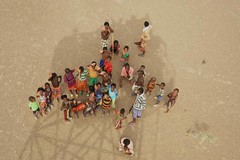 Galha itself was an interesting because it was originally built by MSF (Medicines Sans Frontiers) in the 90s. Their project didn’t work and they pulled out of the region, leaving the empty buildings. According to Valerie, they wasted millions of dollars setting up a health centre, but there was a real division between the MSF and local workers and no real skills transfer. MSF didn’t stay long and left Gahla as a ghost town.
Galha itself was an interesting because it was originally built by MSF (Medicines Sans Frontiers) in the 90s. Their project didn’t work and they pulled out of the region, leaving the empty buildings. According to Valerie, they wasted millions of dollars setting up a health centre, but there was a real division between the MSF and local workers and no real skills transfer. MSF didn’t stay long and left Gahla as a ghost town.
We returned to Logia and stayed in Valerie and Ismael’s compound. There is plenty more to write, but I will never get this blog posted. In Valerie’s book, Maalika, there is a quote which says:
To give and not to count the cost.
To fight and not to heed the wounds.
To toil and not to seek rest.
To labour and not to seek any reward,
Save that of knowing that we do your will.
This sums up Valerie’s attitude to her work and passion. We all found this visit to meet Valerie, Ismael and the Afar people incredibly inspirational. To buy Valerie’s book, or to support the APDA, please visit their website (by clicking on the logo on the Partners’ page) or contact AngliCORD, www.anglicord.org.au.
We returned to Awash, a full day’s drive, in readiness to start the next phase to Somaliland.
